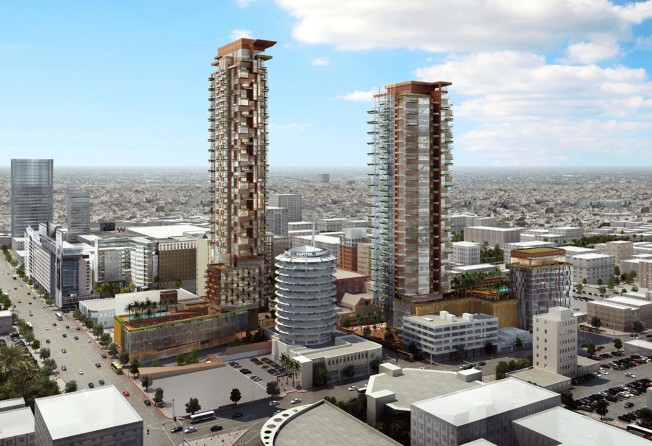Quake fault concerns plague building of Millennium towers in Los Angeles
Construction of Millennium towers suspended pending outcome of lawsuit amid safety worries

The proposed Millennium towers, two skyscrapers that would soar against the Hollywood Hills, were supposed to be a powerful symbol of the campaign to transform Hollywood into a bustling urban hub.
But, these days, as Los Angeles emerges from a steep economic decline, the project has instead become a symbol of something more worrisome: whether ambitious development plans can overcome the complications that come with constructing new buildings and protecting old ones in a region crisscrossed with dozens of earthquake faults.
The Millennium towers project was suspended this autumn, before ground was broken, pending the outcome of a lawsuit filed by opponents citing warnings that the property might straddle a fault. At the same time, two reports, one by the University of California and a second by The Los Angeles Times, found that up to 1,500 concrete buildings built before 1975 were structurally vulnerable to collapse under the powerful force of a big earthquake.
This confluence of events means that Los Angeles is caught in the kind of emotional debate that typically takes place only in the immediate aftermath of a powerful earthquake. The issues involved are the widely acknowledged deficiencies in earthquake preparation here and the obligations of government and landlords to protect old and new buildings. The last major earthquake rumbled through here in 1994.
"The whole city of Los Angeles has faults running through it," said Mitch O'Farrell, a city council member who represents Hollywood and voted in favour of the towers, known as the Millennium Hollywood. "The hard question is: do we halt all development in Hollywood? Do we wait for that 11,000-year earthquake? We are going to go down a very slippery slope if we halt all construction for an earthquake fault that hasn't been defined."
Lawmakers are considering a number of steps, including embarking on a survey of vulnerable buildings, appointing an official in charge of earthquake preparation and examining what can be done about the slow pace of the state geologist's mapping of earthquake faults here. The city's new mayor, Eric Garcetti, has found himself balancing two constituencies: business owners worried about the cost of reinforcing old buildings, and geologists who warn of large-scale and preventable casualties.
"From the outset, my administration has been working on the full spectrum of issues, including structural engineering, emergency services and the preparedness of our residents for when the 'Big One' comes," Garcetti said.
The Millennium towers have run into trouble, because they could fall within 15 metres of a fault line, which would violate the earthquake safety law that was passed after the 6.6-magnitude San Fernando Valley earthquake in 1971. The key word is "could": the uncertainty reflects the inability of state geologists, struggling with state budget cuts, to complete maps of faults in many parts of Los Angeles, including the one in Hollywood.
A coalition of homeowners filed the suit against the project, asserting that the developers knew about and were hiding the dangers of the fault.
"They are creating an earthquake hysteria," Philip Aarons, one of the Millennium developers, said of the homeowners.